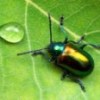I sometimes get requests for stylistic pictures of dead ants. From pest control industry folks, usually. And I always have to beg off. Somehow, with my global image library of hundreds of different ant species, I've had nothing but live insects. Dead bugs never held much aesthetic appeal, I guess.
Well, Pest Control People. Just for you I've sold out. Here, at last, is your ex-ant.


(Incidentally, this ant wasn't even dead. It was knocked out with CO2 and walked off 5 minutes later.)

Do you have any suggestions for using CO2 to knock out insects temporarily? I'm not too concerned myself about lifelike poses, so much as just getting them to hold still without looking obviously dead. The refrigerator trick works about half of the time, but up here near Lake Superior, a lot of arthropods are so cold-tolerant that it barely slows them down.
Hi Tom. This use of CO2 was indirect: I fully stoppered the test tube that held the ant colony for about 8 hours, at which point some of the ants started to pass out. It's generally easier to use dry ice if you have a source of it, though, as that's just frozen CO2 anyway.
I've used CO2 before for research purposes, but I've never adopted it for photography. Even though it's better than the fridge, the bugs still don't look quite right.
My setup may be more complicated than others, as I have no idea how others anesthetize their insects - but I chop the bottom off a 15ml centrifuge tube and cover it with mesh, put the insect inside, cap the tube, poke holes in the cap, then plonk the mesh end onto a hose coming out of my CO2 tank (depending on your hose, you may need to devise a connector of some sort), and turn on the gas. My parasitoids take usually less than 5 seconds of gas, beetles seem to take longer, but it varies based on their size. Beetles still look somewhat lifelike, but the parasitoids always look so dead that I'm never sure if I've killed them until they wake up again -- not sure if that will suit your needs! Hope this helps.
Hilarious ant photo btw - totally made my morning.
Dead insects: an category of stock photography I'd not even previously considered. Not that I'm going to run out and begin practicing it, mind you; it's just one of those interesting things to know.
The very first thought that flitted through my brain when I saw the first photo was "Paws up!" :)
Mrmacophyl would like these. ;)
Your blog is a great place in the internet. Very interesting. I always come in for see news and interested contents. Mentalidade